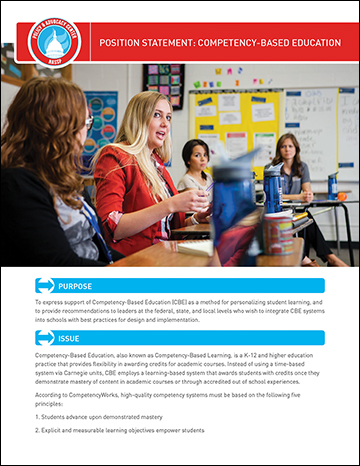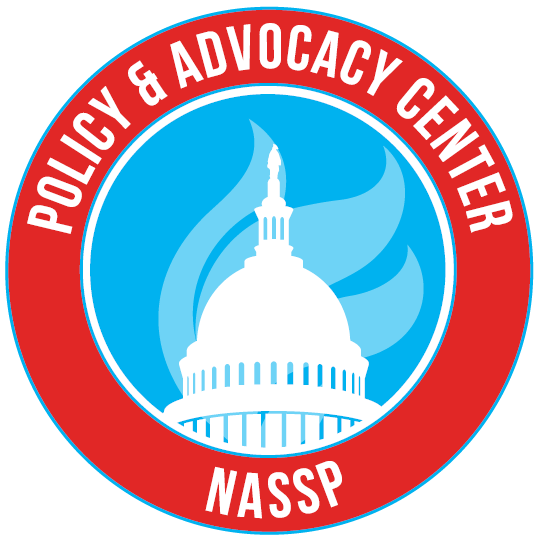To express support of Competency-Based Education (CBE) as a method for personalizing student learning, and to provide recommendations to leaders at the federal, state, and local levels who wish to integrate CBE systems into schools with best practices for design and implementation.
Competency-Based Education, also known as Competency-Based Learning, is a K-12 and higher education practice that provides flexibility in awarding credits for academic courses. Instead of using a time-based system via Carnegie units, CBE employs a learning-based system that awards students with credits once they demonstrate mastery of content in academic courses or through accredited out of school experiences.
According to CompetencyWorks, high-quality competency systems must be based on the following five principles:
- Students advance upon demonstrated mastery
- Explicit and measurable learning objectives empower students
- Assessment is meaningful and a positive learning experience for students
- Students receive rapid, differentiated academic and transitional support
- Learning outcomes emphasize the application and creation of knowledge
CBE was developed because students learn in different ways and at their own pace. The amount of time that a student spends learning a subject does not necessarily determine mastery of course content. In our current time-based education system, students earn letter grades and typically receive diplomas after earning 120 credit hours, even though they may not have truly mastered the content.
As a result, many students entering postsecondary institutions are required to take remedial courses, which can increase the expense of pursuing a postsecondary degree by increasing the amount of courses required to graduate. The National Center for Education Statistics has found that as of 2008, 20.4 percent of students attending postsecondary institutions required some level of remedial education. Additionally, the National Conference of State Legislatures estimates that remedial education costs students, parents, and states $2.3 billion annually.
In a CBE system, students are provided with personalized learning opportunities that can include online and blended learning, dual enrollment and early college high schools, project-based and community-based learning, and credit recovery. Instead of relying solely on standardized assessments, students can demonstrate mastery of content in a variety of ways, including essays, portfolios, exhibitions, performances, and internships.
In Breaking Ranks 1996, it was recommended that high schools abandon or revise the Carnegie unit so they no longer equate seat time with learning. In 2005, New Hampshire eliminated the Carnegie unit and passed legislation requiring all high schools to implement competency education by 2008. As part of New Hampshire’s implementation of Competency-Based Education, the New Hampshire Association of School Principals (NHASP) selected a group of six principal leaders to receive training on Breaking Ranks II as they enter the implementation phase within their schools. NHASP also established a series of regional principal’s network meetings that gave principals the opportunity to learn from one another on reform efforts, challenges, and solutions.
As of 2015, 40 states have revised policies to allow for proficiency-based diplomas, waived seat time to allow competency-based pathways, created credit flexibility, or initiated a redesign of their education system around student learning. If implemented correctly, CBE has the potential to expand and improve the education experience for students in order to ensure they acquire the necessary skills to be college and career ready. In addition, CBE can save time and money by establishing multiple pathways to graduation.
Guiding Principles
Principals are responsible for ensuring that each student receives the highest quality instruction every day and that teachers in the school have the resources and support to deliver this type of learning.
NASSP believes that all students should graduate from high school with the skills to help them succeed in postsecondary education and the workplace.
NASSP’s position statement on Tracking and Ability Grouping in Middle Level and High Schools suggests that principals should provide a safe and personalized learning environment for each student while also identifying a set of essential learnings in which students must demonstrate competency in order to move to the next level.
In Breaking Ranks II and Breaking Ranks in the Middle, school leaders are provided with a framework for improving the performance of each student by: implementing best practices through collaborative leadership and professional learning communities, creating relevance through personalizing the environment, and addressing issues of rigor through curriculum, instruction, and assessment.
Recommendations
Recommendations for Federal and State Policymakers
- Create space for innovation by removing time-based constraints from regulation, including competency education in innovation grants and increasing investments in evaluation, research, and development.
- Redesign accountability frameworks to support higher and deeper levels of personalized learning that establish mutual accountability, a culture of learning, collaboration, and capacity building.
- Build robust supports and interventions that track students’ progress in real time in order to drive more timely school improvement efforts.
- Invest in competency-based information technology that provides transparent information on where students are along a learning trajectory so that educators can customize learning experiences and ensure that every student demonstrates mastery.
- Establish expanded learning opportunities that give students the opportunity to demonstrate learning and receive credit through work experience or community service.
- Institute competency-based diplomas that paint a more accurate picture of student mastery and skill acquisition, and enable students to graduate before or after the four years of instruction.
Recommendations for District Leaders
- Begin identifying competencies and skills that students must be equipped with in order to be adequately prepared for college and the 21st-century global economy.
- Establish a working group of parents, community members, teachers, curriculum specialists, principals, superintendents, business leaders, and policymakers tasked with developing a shared vision and district culture that put students at the center of learning.
- Develop a school environment in conjunction with school counselors that supports students who stay behind or advance ahead of their peers.
- Provide training to elementary, middle, and high school leaders and other school staff on the challenges and best practices for implementing competency-based systems.
- Create a variety of assessments to accommodate for multiple learning pathways that are transparent and ongoing, and provide meaningful feedback to support student learning.
Recommendations for School Leaders
- Deliver training to educators on how to modify classroom instruction to incorporate competency-based learning.
- Establish a school culture that empowers parents, teachers, and students to give and receive support in order to ensure students take ownership in their learning and truly understand the path towards mastery of content.
- Develop personalized interventions for students who are struggling to demonstrate mastery of content.
- Conduct a thorough review of literature trends of competency-based education practices across the country.
- Visit schools and make contact with school leaders who have begun implementing competency-based education systems.
Resources
Council of Chief State School Officers (2014). Roadmap for competency-based systems: Leveraging next generation technologies.
Darling-Hammond, L., G. Wilhoit & L. Pittenger (2014). Accountability for college and career readiness: Developing a new paradigm. Stanford Center for Opportunity Policy in Education.
L., Cecilia, R. Wolfe & A. Steinberg (September 2014). The past and the promise: Today’s competency education movement. Jobs for the Future.
National Conference of State Legislatures. Hot topics in higher education: Reforming remedial education. Retrieved from: http://www.ncsl.org/research/education/improving-college-completion-reforming-remedial.aspx.
National Association of Secondary School Principals (1996). Breaking Ranks: Changing an American institution. Reston, VA: Author.
NASSP Position Statement on Common Core State Standards and Assessments in K-12 Education (July 2013). Retrieved from: https://www.nassp.org/policy-advocacy-center/nassp-position-statements/common-core-state-standards-and-assessments-in-k-12-education/.
NASSP Position Statement on High Stakes Assessments (February 2015). Retrieved from: https://www.nassp.org/policy-advocacy-center/nassp-position-statements/high-stakes-assessments/.
NASSP Position Statement on Promoting Rigorous Courses for All Students (November 2014). Retrieved from: https://www.nassp.org/policy-advocacy-center/nassp-position-statements/promoting-rigorous-courses-for-all-students/.
NASSP Position Statement on Tracking and Ability Grouping in Middle Level and High Schools (July 2006). Retrieved from: https://www.nassp.org/who-we-are/board-of-directors/archived-position-statements/tracking-and-ability-grouping-in-middle-level-and-high-schools/.
Patrick, S. & C. Sturgis (2013). Necessary for success: Building mastery of world-class skills, a state policymakers guide to competency education. CompetencyWorks.
Patrick, S., K. Kennedy & A. Powell (October 2013). Mean what you say: Defining and integrating personalized, blended, and competency education. International Association for K-12 Online Learning.
Schwartz, K. (July 2015). Steps to help schools transform to competency-based learning. KQED News. Retrieved from: http://ww2.kqed.org/mindshift/2015/07/09/steps-to-help-schools-transform-to-competency-based-learning/.
Shubilla, L. & C. Sturgis (December 2012). The learning edge: Supporting student success in a competency-based learning environment. CompetencyWorks.
Sturgis, C (June 2015). Implementing competency education in k-12 systems: Insights from local leaders. ComptencyWorks.
Sparks, D. & N. Malkus (January 2013). First-year undergraduate remedial coursetaking: 1999–2000, 2003–04, 2007–08. National Center for Education Statistics Institute for Education Sciences.
Tanenbaum, C., K., Floch, & A. Boyle (August 2013). Are personalized learning environments the next wave of K–12 education reform? American Institute of Research.
Torres, A., J. Brett & J. Cox (2015). Competency-based learning: Definition, policies, and implementation. Regional Educational Laboratory at the Education Development Center.
Worthen, M & L. Pace (February 2014). A K–12 federal policy framework for competency education: Building capacity for systems change. CompetencyWorks.


